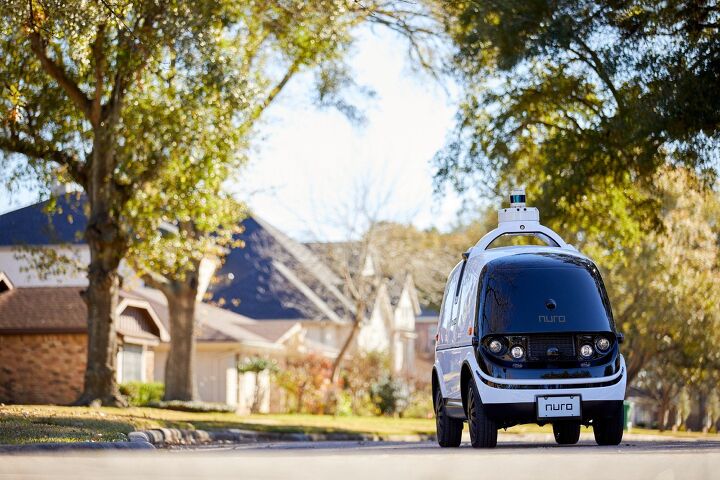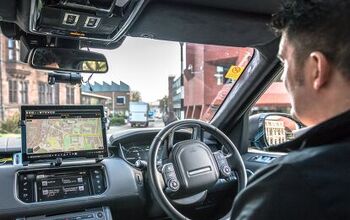California Greenlights Autonomous Delivery Vehicles for Public Roads

On Tuesday, self-driving startup Nuro received a permit from the State of California to commence testing on certain public roads. Issued by the state’s Department of Motor Vehicles, the document allows its fleet of driverless delivery bots to mingle with traffic.
On a national level, Nuro’s vehicles are technically illegal without a smidgen of government help. U.S. Federal Motor Vehicle Safety Standards mandate road-going automobiles have things like windshields, airbags, and mirrors. Meanwhile, Nuro’s small delivery units don’t even have space for a driver — requiring the Department of Transportation to make regulatory exemptions for the brand in February after debating the issue for over a year.
The only other company to have gotten this far with oversight groups is Waymo, the Alphabet-owned cab service that still prefers to keep safety drivers handy whenever possible. The two businesses, however, are quite different in their missions. Waymo has envisioned AVs as people movers since it was still calling itself the “Google Self-Driving Car Project.” Meanwhile, Nuro framed them as an extension of traditional robotics. While it acknowledges that self-driving vehicles would have the ability to shuttle around commuters, it has maintained a strong focus on delivery applications.
That allowed the current health pandemic to work in its favor. China made similar exemptions for small, self-driving delivery vehicles after Wuhan was placed under quarantine. Stickers on the vehicles indicated that they had recently been disinfected (while touting safe, no-contact deliveries). California has been in lockdown since March 19th, when Gov. Gavin Newsom ordered all residents to stay home. While the official reasons for allowing Nuro to operate on California roads doesn’t include “response to statewide health crisis,” Chief Legal & Policy Officer David Estrada understands it’s a factor:
Nuro’s founding mission, to accelerate the benefits of robotics for everyday life, has never felt more real to us than it does today. Admittedly, while we have always believed that self-driving delivery vehicles would improve road safety and provide valuable convenience to consumers, we did not foresee our service helping to keep Americans safe from contagion. But the COVID-19 pandemic has expedited the public need for contactless delivery services. Our R2 fleet is custom-designed to change the very nature of driving, and the movement of goods, by allowing people to remain safely at home while their groceries, medicines, and packages, are brought to them.
Today, as we live through a public health crisis, Nuro has received the first permit ever granted by the State of California to test a self-driving vehicle on public roads that is not only driverless, but also passengerless. It is only the second driverless testing permit California has granted to any company. This permit now allows Nuro to begin testing our recently unveiled R2 vehicle, in service with our partners, starting in the Silicon Valley region.
Designed to navigate tight corridors, the R2 measures only about 43 inches wide and 108 inches long, despite having the same overall height as a regular sedan. With no space for a driver, interior volume is utilized entirely for the stowage of goods. The doors swing upward and mounted high to allow for curbside deliveries. It’s actually a thoughtful little package with real usefulness baked into its design — even if it weighs as much as a Honda Fit and can only haul 418 pounds worth of cargo in a space smaller than some trunks.
Entirely electric, the R2 uses a 31-kWh battery and has a top speed of 25 mph. While that makes long-range runs a problem, that wasn’t a task that ever appeared on the little droids’ roof-mounted radar. The R2 is designed for operation in densely populated urban areas and might not work anywhere else, from a business perspective. This type of service needs plenty of regular customers to offset operational costs and the considerable R&D that goes into their development. Expecting one to run 40 miles out to the nearest farmhouse probably isn’t in the cards. Still, it might work in serving 20 people who all live within 10 miles of each other, especially if they’re disinclined to leave the house.
There are other potential applications, too. Vehicles like Nuro’s R2 could run supplies between hospitals if infection rates suddenly ramp up in nearby areas. Yet everything hinges on the effectiveness of the systems these vehicles use to navigate through their environment. Progress on self-driving has proven less impressive than the tech and automotive industries had hoped. Still, the NHTSA has allowed Nuro to field 5,000 test vehicles without drivers to see how it fares.
For now, it cannot legally charge for deliveries and its currently assessing its strategy for deployment in California. That might actually postpone the launch until after COVID-19 subsides somewhat, as Nuro has said it plans on adhering to California’s social-distancing measures to keep its own workforce safe.
[Images: Nuro]

A staunch consumer advocate tracking industry trends and regulation. Before joining TTAC, Matt spent a decade working for marketing and research firms based in NYC. Clients included several of the world’s largest automakers, global tire brands, and aftermarket part suppliers. Dissatisfied with the corporate world and resentful of having to wear suits everyday, he pivoted to writing about cars. Since then, that man has become an ardent supporter of the right-to-repair movement, been interviewed on the auto industry by national radio broadcasts, driven more rental cars than anyone ever should, participated in amateur rallying events, and received the requisite minimum training as sanctioned by the SCCA. Handy with a wrench, Matt grew up surrounded by Detroit auto workers and managed to get a pizza delivery job before he was legally eligible. He later found himself driving box trucks through Manhattan, guaranteeing future sympathy for actual truckers. He continues to conduct research pertaining to the automotive sector as an independent contractor and has since moved back to his native Michigan, closer to where the cars are born. A contrarian, Matt claims to prefer understeer — stating that front and all-wheel drive vehicles cater best to his driving style.
More by Matt Posky
Latest Car Reviews
Read moreLatest Product Reviews
Read moreRecent Comments
- Rover Sig 2021 Jeep Grand Cherokee Limited, like my previous JGC's cheap to keep (essentially just oil, tires) until recent episode of clunking in front suspension at 50K miles led to $3000 of parts replaced over fives visits to two Jeep dealers which finally bought a quiet front end. Most expensive repair on any vehicle I've owned in the last 56 years.
- Bob Hey Tassos, have you seen it with top down. It's a permanent roll bar so if it flips no problem. It's the only car with one permanently there. So shoots down your issue. I had a 1998 for 10 years it was perfect, but yes slow. Hardly ever see any of them anymore.
- 3-On-The-Tree 2007 Toyota Sienna bedsides new plugs, flat tire on I-10 in van Horn Tx on the way to Fort Huachuca.2021 Tundra Crewmax no issues2021 Rav 4 no issues2010 Corolla I put in a alternator in Mar1985 Toyota Land Cruiser FJ60 280,000mi I put in a new radiator back in 08 before I deployed, did a valve job, new fuel and oil pump. Leaky rear main seal, transmission, transfer case. Rebuild carb twice, had a recall on the gas tank surprisingly in 2010 at 25 years later.2014 Ford F159 Ecoboost 3.5L by 80,000mi went through both turbos, driver side leaking, passenger side completely replaced. Rear min seal leak once at 50,000 second at 80,000. And last was a timing chain cover leak.2009 C6 Corvette LS3 Base, I put in a new radiator in 2021.
- ChristianWimmer 2018 Mercedes A250 AMG Line (W177) - no issues or unscheduled dealer visits. Regular maintenance at the dealer once a year costs between 400,- Euros (standard service) to 1200,- Euros (major service, new spark plugs, brake pads + TÜV). Had one recall where they had to fix an A/C hose which might become loose. Great car and fun to drive and very economical but also fast. Recently gave it an “Italian tune up” on the Autobahn.
- Bd2 Lexus is just a higher trim package Toyota. ^^



































Comments
Join the conversation
We'll see if it works....
Leave it to California to screw this pooch. Autonomous vehicles should be outright illegal. Failing that, every "unintended consequence" including collisions needs to be legally the responsibility of the company manufacturing the autonomous vehicle.